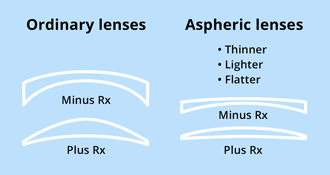Aspheric vs. Spherical
Aspheric or Spherical? Which is Best?
Conventional spherical lenses ae lenses that have the same curvature across the entire front surface. These designs have some distortion when you look away from the center of the lens in any direction. Strong prescriptions for hyperopia or “farsightedness” produced in spherical lenses result in unwanted magnification causing objects to appear larger and closer than they actually are. Consequently, the wearer’s eyes also look larger. Strong prescriptions for myopia or “nearsightedness” do just the opposite. They make objects look smaller and further away while making the wearer’s eyes look smaller.
Superior Vision and Appearance
Aspheric lenses have a more complex front surface than spherical lenses. The front curve gradually changes from the center of the lens to the edge. This design technology allows eyeglass lenses to be made with flatter curves resulting in a thinner and more attractive profile for nearly all prescriptions.
Aspheric lens designs reduce or eliminate the distortion when the wearer looks away from the center of the lens creating a wider field of view with better peripheral vision. These lenses also greatly reduce the magnification and minification of the wearer’s eyes providing a more natural appearance to others.
Due to the fact that the benefits of aspheric lenses increase as the prescription gets stronger, most high-index lenses are aspheric. By combining an aspheric design with a high-index material, strong prescriptions are noticeably thinner, lighter and have a slimmer profile allowing more frame options for the wearer. Since these lenses are flatter and sit closer to the eye than conventional spherical lenses, some wearers may notice more reflections off the front and back surfaces. For this reason, anti-reflective coating is highly recommended. Lens Pricing
In summary Aspheric lenses:
- are less “bulgy” providing a sleeker profile
- provide more frame options for strong prescriptions
- produce a more natural appearance
- improve peripheral vision and overall image quality
- are lightweight
Tints
